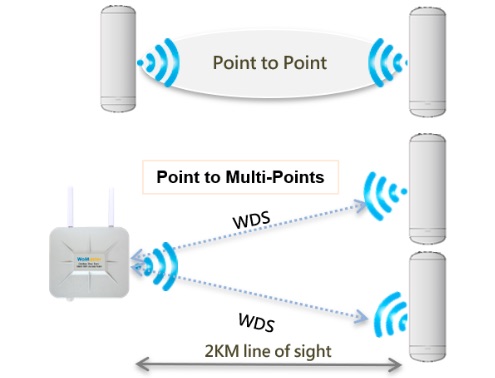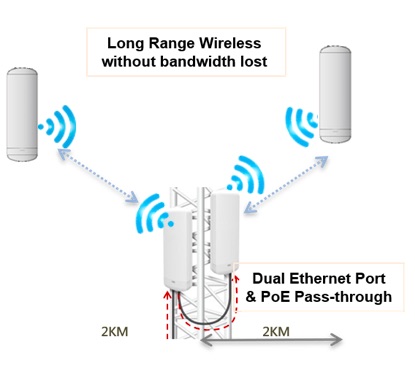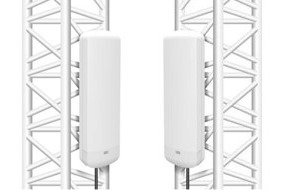One of the biggest challenges in modern networking is spanning large distances while staying within a budget.
Unfortunately, cheap hardware usually fails to accommodate longer ranges or succumbs to harsh outdoor environments. This situation forces you into more expensive technologies, like fiber optics, which may not be affordable.
Point-to-point wireless bridge technology could be the perfect solution you seek. It allows Wi-Fi communication to reach spans further than the IEEE 802.11b/g/n standard of a few hundred feet.
Bridging helps networks transmit across miles using traditional Wi-Fi, cutting installation costs by magnitude. Likewise, it offers better performance than many competing solutions.
So, let’s explore point-to-point wireless bridging and all that it offers. You might have found the best way to solve your networking challenges with this device.
The Architecture of a Wireless Point-to-Point Bridge

Point-to-point wireless bridging is one of the most reliable ways to connect remote Wi-Fi assets. It presents an option for outdoor applications and campus-level networking to connect access points and clients over an area. Even better, it does not need excessive and costly cabling.
The technology typically works using directional line-of-sight antennas, which concentrate the signal to each point in the bridge. Hence, it enables stronger reception and transmission and less power consumption.
The architecture also mitigates signal-to-noise problems and data loss. For these reasons, line-of-sight Wi-Fi typically maintains 99.99% reliability.
Affordable Point-to-Point Wireless Bridge Outdoor Solutions
Westward Sales offers point-to-point and point-to-multipoint wireless bridge packages designed and manufactured by Proxim Wireless and Antaira Technologies.
A pair of preconfigured bridges is available. This option saves time and trouble, particularly in network design and deployment.
One example of a powerful point-to-multipoint is the Proxim MP-1015. This outdoor-rated base station and subscriber functions as an access point, bridge, or repeater. It also operates on the 5 GHz band.
It can maintain 200 Mbps throughput using internal 4×4 35-degree directional MIMO panel antennas with 15 dBi gain. This point-to-point wireless bridge outdoor solution also includes a PoE port for data and power.
Built to work in outdoor and harsh conditions, it features an ingress protection rating of IP67. Additionally, it operates within temperatures between -30 and 55°C.
A popular package from Antaira Technologies is a pair of preconfigured AMY-5133s named the AMY-5133-AC-PD-KIT. It comes as a keyed pair that bridges two points without any setup onsite.
Preconfiguration includes the necessary device setup — IP assignment, SSID, WPA2-PSK encryption, and point-to-point mode — for fast deployment and plug-and-play operation. The device pair also comes with a bundled price that saves money.
8 Advantages of Preconfigured Point-to-Point Wireless Network Bridge
The AMY-5133-AC-PD-KIT (a pair of AMY-5133 Wi-Fi access points) is designed for easy setup and use. It is preconfigured and tested to work together, saving you valuable installation time.
With high-performance, long-range communication, affordability, and more, they’re the efficient solution you’ve been looking for:
1. Easy Network Extension and Adaptation
The most significant advantage of the AMY-5133-AC-PD-KIT is that it comes preconfigured. This feature is more than just a generic plug-and-play setup as the IP assignment, point-to-point mode, and encryption it sets.
Thus, this point-to-point bridge wireless solution is the easiest and quickest way to add new bridges to your network. You simply mount them wherever you want to expand the network, point the directional antennas to each other. And then, apply power.
2. Lowering Outdoor Infrastructure Costs
Reliable outdoor connections are cumbersome. Many systems rely on wired networking, but that is prohibitively expensive for considerable distances.
Copper wire Ethernet runs are limited to 100 meters. Even with Ethernet extenders, they can’t handle longer distances without performance degradation.
Alternative solutions, like long-range fiber optics, quickly increase the cost. Wireless point-to-point bridge technology provides a reliable connection up to 1.25 miles out of the box. It can even go further with higher-gain antennas.
As a result, there is no need for expensive cabling, and the overall infrastructure costs for the network drop precipitously.
In addition, because these are line-of-sight devices, the connection integrity is more substantial than traditional wireless. Thus, it allows for faster connections with less latency.

3. High-Level Security
High-level network security protocols prevent most vulnerabilities plaguing point-to-point outdoor wireless bridge systems. Thus, you can confidently use the AMY-5133-AC-PD-KIT wireless bridge pair in outdoor public spaces. Also, you reap the benefits of a robust wireless network.
Additionally, the AMY-5133-AC-PD-KIT is designed for WPA2-PSK security. Fully encrypted communication prevents most direct network attacks that could compromise your network and secure information.
Considering the long-range applications of point-to-point wireless, it’s a doubly important issue.
4. High-Speed Networking
Line-of-sight devices like the AMY-5133-AC-PD are capable of high speeds. The best point-to-point wireless bridge system can exceed 300 Mbps at distances longer than a full mile. So, it makes them more capable than Fast Ethernet.
When you consider the cabling costs to run Fast Ethernet over outdoor distances, you save money while boosting performance. The operational speed is high enough to negate the need for more expensive equipment options.
Unless you require Gigabit or 10G connections, point-to-point wireless can save you tons of money on infrastructure costs.
5. Layer 3 Features
Layer 3 features are enticing for any network administrator. These wireless point-to-point bridge devices support remote access via OpenVPN and IPSec. They also include event warnings and built-in network troubleshooting assistance.
They come equipped with firewall security and support NAT to improve privacy and security. The full range of Layer 3 features allows for more network control, access, and security.
6. Passive PoE
Each point-to-point wireless bridge has two passive PoE ports, making network design and deployment even more manageable. The bridge supplies power to essential endpoint devices, like security video cameras.
Once again, the hardware cuts cabling costs and increases your available resources and assets within the point-to-point bridge wireless network.
7. Integrated Cloud Support
Cloud support is vital in almost every application, and this system provides full cloud support. These point-to-point bridges work with popular cloud platforms like AWS and Azure Cloud.
8. Light-Weight Equipment
The AMY-5133-AC-PD units weigh less than one pound apiece. That makes them easy to handle and mount securely.
The lightweight lowers installation costs, particularly regarding labor, and allows convenient placement without needing heavy-duty masts or brackets.
The Bottom Line on Point-to-Point Wireless Bridge Networks
Point-to-point Wi-Fi bridging is a cost-effective and excellent method of wireless communication. If you want to explore networking possibilities fully, Westward Sales can help.
Contact Westward Sales today and speak with one of our experts. We will discuss your operation and the specific network challenges that you face.
Our comprehensive list of hardware and system solutions will consolidate equipment, save money, and fulfill nearly every networking requirement. If you want the most out of your network, we can be one of your most valuable resources.

Hi,
I am currently designing an 8 building campus with 4 verifocal lens and 2 LP cameras on each building.
Designing fiber network back to main MDF and NVRs. would your system have the bandwidth to manage this?
Yes, it would have the bandwidth. We need to know the total data output from the cameras to match the right access points.